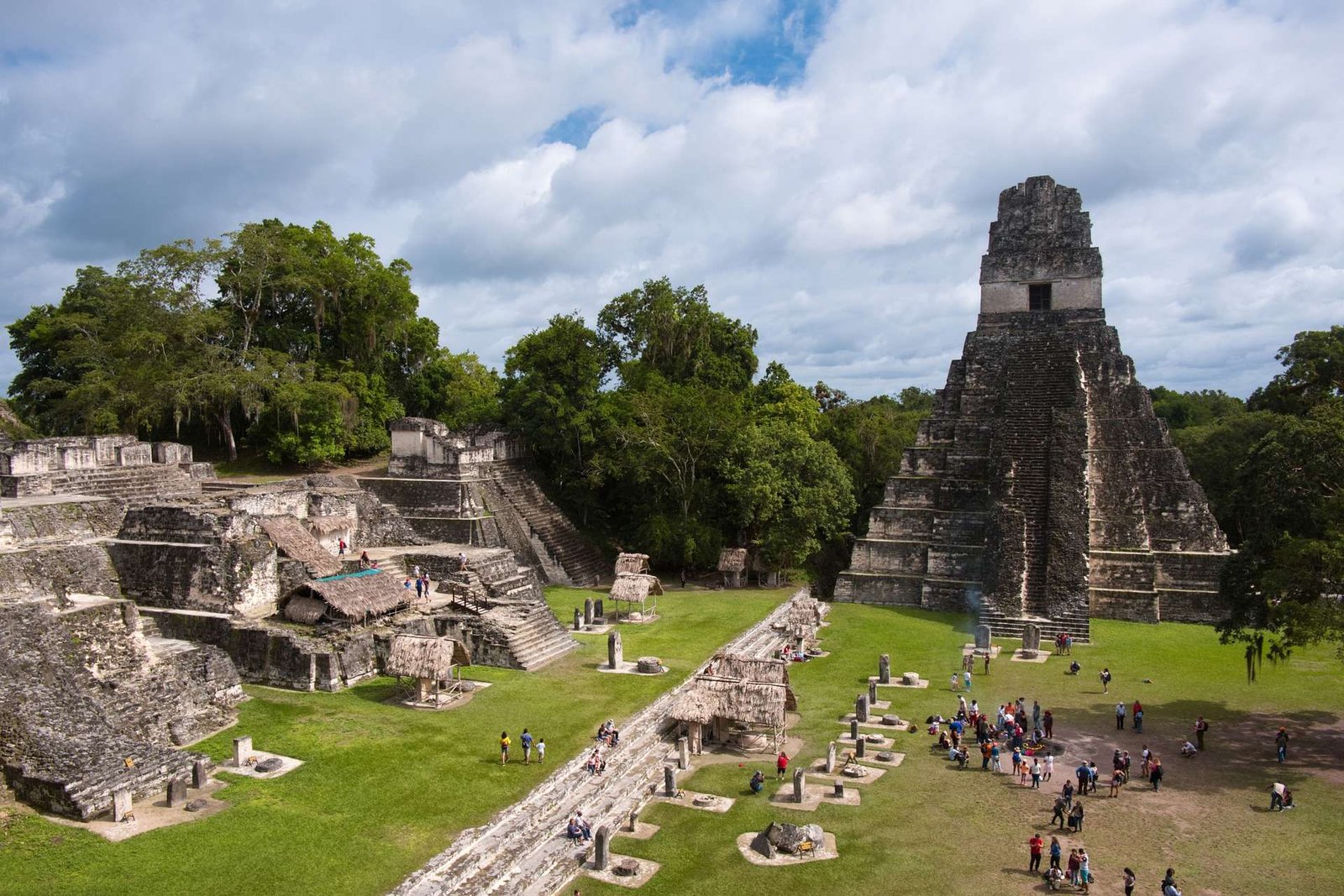Coffee and tea are beloved beverages that not only provide a much-needed caffeine boost but also serve as gateways to exploring different cultures and cuisines. If you’re a coffee or tea enthusiast, you’re in luck! The United States is home to some of the best food destinations for coffee and tea lovers. From iconic coffee shops to charming tea houses, there’s something for everyone to indulge in the rich flavors of these beverages.
Key Takeaways:
- Whether you’re a coffee connoisseur or a tea enthusiast, the United States offers a plethora of options for you to explore and indulge in.
- From iconic coffee shops to charming tea houses, there’s a wide range of food destinations that cater to coffee and tea lovers.
- These destinations provide a unique and immersive experience, allowing you to not only enjoy delicious coffee and tea but also learn about the rich cultures and traditions associated with them.
- Consider going on coffee or tea tours to fully immerse yourself in the flavors and stories behind these beloved beverages.
- Food destinations for coffee and tea lovers are not just about the drinks themselves but also about the ambiance, the people, and the sense of community that they offer.
Costa Rican Café: A Paradise for Coffee Lovers
When it comes to exceptional coffee, Costa Rica shines as a top destination for coffee lovers. The country’s commitment to quality coffee production, strict regulations, and rich coffee culture make it a true paradise for coffee enthusiasts.
Costa Rica is well-known for its dedication to cultivating and producing high-quality coffee. The country’s stringent regulations prohibit the cultivation of anything other than 100% Arabica beans, ensuring that only the best coffee is made available to consumers. Arabica beans, known for their distinct flavor and aroma, create a truly exceptional coffee experience.
The flavors found in Costa Rican coffee are a testament to the country’s commitment to excellence. With notes of fruit, chocolate, nuts, and caramel, Costa Rican coffee offers a delightful and nuanced taste that coffee connoisseurs appreciate. The smoothness of Arabica beans also enhances the drinking experience, making it easier to savor every sip.
| Highlights of Costa Rican Café: | Benefits of Costa Rican Coffee: |
|---|---|
| 1 Exceptional coffee production | 1 Strict regulations ensure high-quality coffee |
| 2 Rich coffee culture and heritage | 2 Unique flavors with notes of fruit, chocolate, nuts, and caramel |
| 3 Wide variety of coffee flavors to explore | 3 Lower caffeine content for a smoother drinking experience |
Visiting Costa Rica allows coffee lovers to indulge in specialty coffees created with care and precision. From small-scale coffee estates to larger plantations, there are numerous opportunities to witness the coffee production process firsthand and even participate in coffee tasting sessions. This immersive experience offers a deeper understanding and appreciation for Costa Rican coffee and its importance in the country’s culture and economy.
So, if you’re a coffee enthusiast looking for a unique and flavorful experience, a trip to Costa Rica’s coffee paradise is a must.
Testimonials from Coffee Lovers
“Costa Rican coffee is like a symphony of flavors in each cup. The combination of Arabica beans and Costa Rica’s coffee-making expertise creates a truly exceptional coffee experience.”
– Emma, Coffee Enthusiast
“I was blown away by the vibrant and complex flavors of Costa Rican coffee. It’s a coffee lover’s dream come true!”
– Michael, Coffee Connoisseur
Moroccan Mint Tea: A Tradition of Hospitality
Mint tea is not just a drink in Moroccan culture; it is a symbol of hospitality and friendship. Steeped in tradition and warmth, Moroccan mint tea is a beverage that brings people together and creates memorable moments.
The process of making Moroccan mint tea is both meticulous and delightful. Fresh mint leaves, green tea, water, and sugar are the essential ingredients used to brew this fragrant and refreshing tea. The tea is prepared using a teapot called a teanij and poured from a height to produce a frothy texture.
“Moroccan mint tea, or atay b’nana in Moroccan Arabic, is a cornerstone of Moroccan culture and is traditionally served to guests as a sign of hospitality and respect.”
The brewing process is done multiple times, with the first brew being the most potent and subsequent brews becoming milder. This technique allows the flavors of the mint and tea to infuse completely, resulting in a tea that is simultaneously sweet, minty, and refreshing.
Experiencing the Moroccan tea ceremony, also known as thé à la menthe, is a beautiful way to immerse oneself in Moroccan culture and hospitality. It is a ceremony filled with warmth, kindness, and tradition. The tea is poured into small, decorative glasses from a height, creating a mesmerizing display.
The Moroccan tea ceremony is not just about the beverage; it is an invitation to connect with the locals and hear their stories, as guests are often engaged in lively conversations while savoring the tea.
The rich cultural significance of Moroccan mint tea, combined with its delightful flavors, makes it a must-try for anyone visiting Morocco. It is an experience that captures the essence of Moroccan hospitality and offers a taste of the country’s vibrant culture.
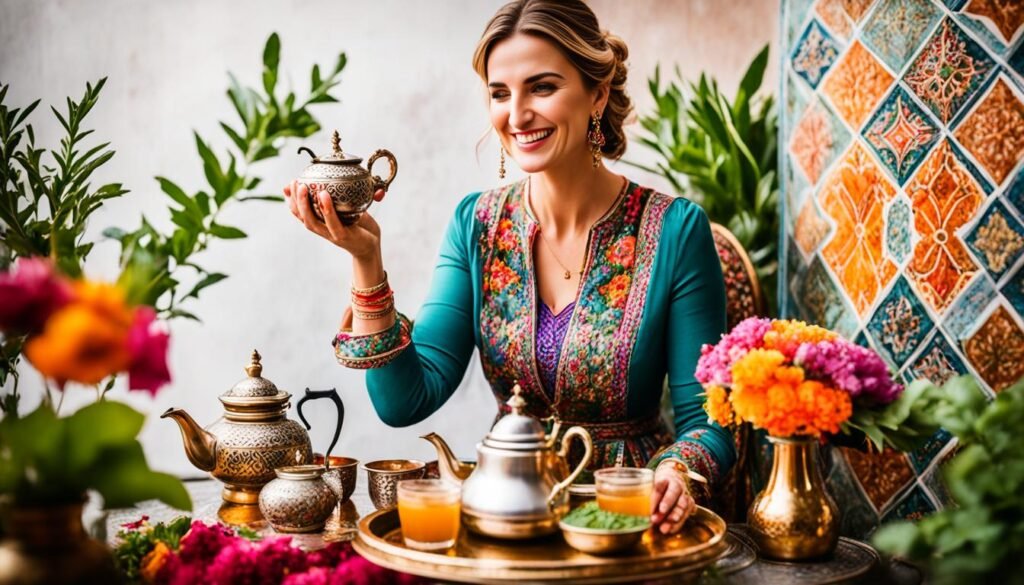
Turkish Çay: A Tea Lover’s Paradise
Turkey is renowned for its tea consumption, making it a true paradise for tea lovers. The rich traditions and rituals associated with Turkish tea create a unique and immersive experience for enthusiasts. Traditional Turkish tea is served without milk and is enjoyed throughout the day, from breakfast to social gatherings. It is deeply ingrained in Turkish culture and is a symbol of hospitality and friendship.
One of the most beloved aspects of Turkish tea culture is the çay keyfi, a leisurely and social activity that involves sharing tea and engaging in meaningful conversations with friends and family. Tea is typically served in small, tulip-shaped glasses known as “çay fincanı” and is often accompanied by delicious traditional biscuits called kurabiye.
The preparation of Turkish tea is an art form in itself. The tea is brewed using a teapot with a double chamber, known as a “çaydanlık,” which allows for the tea to be brewed intensely without becoming bitter. The lower chamber holds boiling water, while the upper chamber contains loose black tea leaves. The brewed tea is then mixed with hot water from the lower chamber to achieve the desired strength.
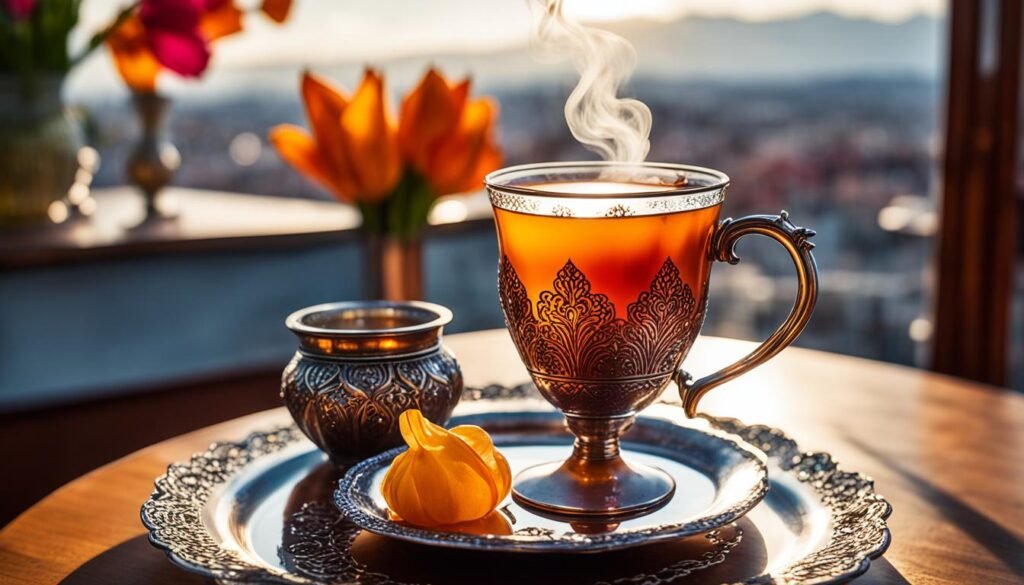
Exploring the tea culture in Turkey provides a wonderful opportunity to not only taste the flavorful tea but also to witness the charming rituals associated with it. Whether you’re sipping tea at a local tea house, known as a “çay bahçesi,” or enjoying a cup in a bustling bazaar, the experience is sure to leave a lasting impression.
“Tea is much more than a beverage in Turkey; it is a catalyst for connection, conversation, and camaraderie.”
So, if you’re a tea lover looking for an exceptional tea-drinking experience, make sure to include Turkish çay in your culinary adventures. Immerse yourself in the warm hospitality and vibrant tea culture of Turkey, and discover the delights of this tea lover’s paradise.
Argentinian Yerba Mate: Sharing Love and Tradition
Yerba mate is a beloved herbal tea that holds a special place in Argentinian culture. This South American tea is prepared by steeping dried leaves in hot water, resulting in a flavorful and energizing beverage. However, yerba mate is more than just a drink; it is a symbol of love, friendship, and tradition.
In Argentina, mate sharing is a common ritual that brings people together. Friends, family members, and even strangers gather in a circle, passing around a gourd filled with yerba mate. Each person takes turns sipping from a metal straw called a bombilla, symbolizing the bond created by this shared experience.
The ritual of sharing mate is an act of connection and camaraderie. It fosters a sense of unity among people, breaking down barriers and creating lasting memories.
Preparing mate requires a meticulous process. The dried leaves are carefully placed in a gourd, and hot water is added to create an infusion. The resulting tea has a unique flavor profile, combining elements of bitterness, earthiness, and a subtle sweetness.
Yerba mate culture is deeply ingrained in Argentinian society. It is enjoyed throughout the day, often accompanied by traditional snacks like empanadas or alfajores. The rich history and tradition behind mate make it a must-try beverage for anyone visiting Argentina.
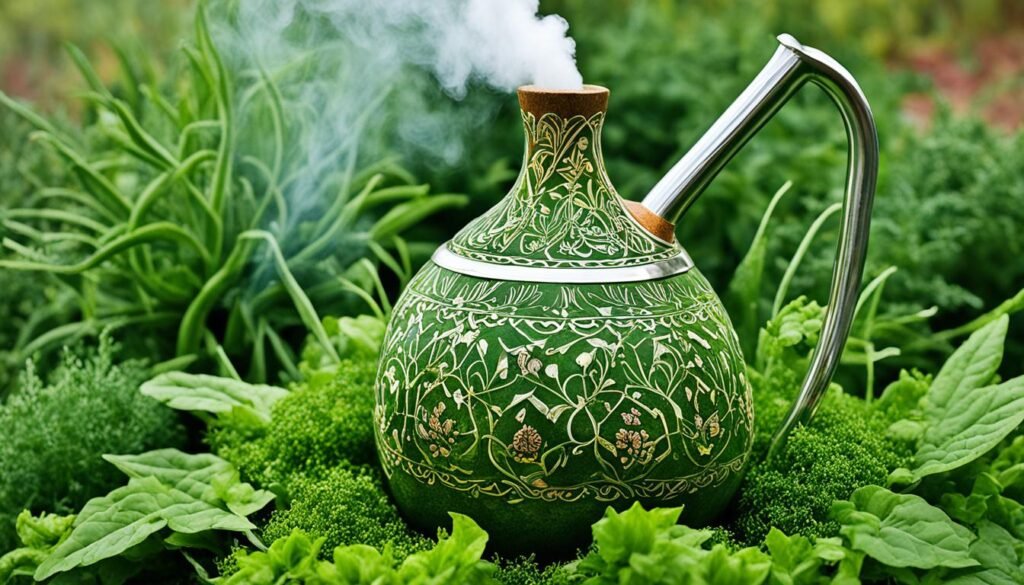
Health Benefits of Yerba Mate
Besides its cultural significance, yerba mate offers numerous health benefits. It is packed with antioxidants and contains vitamins, minerals, and amino acids. Some of the potential health benefits of drinking yerba mate include:
- Boosting energy and mental focus
- Enhancing digestion and metabolism
- Supporting weight loss
- Strengthening the immune system
- Improving cardiovascular health
It’s important to note that while yerba mate has many potential benefits, moderation is key. Like any caffeinated beverage, excessive consumption may have negative effects on health.
Exploring Yerba Mate Culture in Argentina
When visiting Argentina, make sure to immerse yourself in the vibrant yerba mate culture. Participate in a mate sharing ceremony, learn about the traditional preparation methods, and savor the distinctive flavor of this South American tea. Whether you’re exploring the bustling streets of Buenos Aires or venturing into the scenic countryside, you’ll find opportunities to experience the warmth and tradition associated with yerba mate.
So, grab a gourd, sip from the bombilla, and join in the age-old tradition of yerba mate sharing. Discover how this humble beverage brings people together, fosters connection, and leaves a lasting impact on those who embrace its love and tradition.
Vietnamese Coffee: Bold and Flavorful
Vietnam is known for its robust coffee culture, with the country being the second-largest exporter of coffee in the world. Vietnamese coffee is a unique and bold experience for coffee lovers, offering a rich and intense flavor that sets it apart from other varieties.
The key to Vietnamese coffee’s distinct taste lies in the use of Robusta beans. Unlike many other countries that primarily use Arabica beans, Vietnam favors Robusta beans for their bold and strong flavor profile. Robusta beans have a higher caffeine content, making Vietnamese coffee an excellent choice for those seeking a strong caffeine kick.
One popular Vietnamese specialty that coffee enthusiasts must try is egg coffee. This indulgent beverage combines whipped egg yolk, condensed milk, and coffee, creating a creamy and sweet concoction that is beloved by locals and tourists alike. The combination of silky smoothness from the egg and the intense flavor of the coffee makes egg coffee a must-try delicacy in Vietnam’s coffee culture.

Exploring the coffee culture in Vietnam is a journey that encompasses much more than just enjoying a cup of coffee. It’s an opportunity to immerse yourself in the local coffee traditions, witness traditional brewing methods, and interact with passionate coffee enthusiasts. Whether you prefer to savor your coffee black or enjoy it with a twist, Vietnamese coffee offers a bold and flavorful experience that will leave you craving for more.
Guatemalan Coffee: A Paradise for Coffee Enthusiasts
Guatemala is a paradise for coffee enthusiasts, offering a truly remarkable coffee experience. Nestled within its highlands are coffee plantations that produce some of the world’s finest coffee beans. The rich volcanic soil, ideal altitude, and favorable climate create the perfect conditions for growing exceptional coffee.
The art of coffee production in Guatemala is deeply intertwined with the country’s culture and history. Coffee has been a significant part of Guatemala’s economy for centuries, and its export continues to play a vital role in the country’s growth and development.

The specialty coffee produced in Guatemala is known for its exquisite flavors and unique characteristics. The coffee cherries are handpicked and carefully processed to ensure the preservation of the beans’ natural flavors. From the floral and fruity notes to the smooth and chocolatey undertones, every sip of Guatemalan coffee transports you to a world of delight.
“Guatemala’s coffee is truly a gem in the specialty coffee world. The diversity of flavors and the dedication of the farmers make it an unparalleled experience for coffee lovers.” – Coffee connoisseur
Exploring the coffee plantations in Guatemala is a fascinating journey that allows you to witness the entire coffee production process – from the cultivation and harvesting of the coffee cherries to the roasting and brewing of the beans. You can immerse yourself in the coffee culture, interact with passionate coffee farmers, and even participate in coffee tasting sessions to discover the nuances of different coffee flavors.
Key Features of Guatemalan Coffee
| Flavor Profile | Altitude | Processing Method |
|---|---|---|
| Rich, with floral and fruity notes | High-altitude regions ranging from 1,500 to 2,000 meters | Washed, semi-washed, and natural |
| Smooth, with chocolatey undertones | Volcanic slopes and mountainous areas | Handpicked and sun-dried |
| Complex, with a balanced acidity | Shade-grown under the canopy of trees | Unique regional variations |
A cup of Guatemalan coffee is not just a beverage; it’s a journey through the cultural heritage and natural beauty of the country. So, if you’re a coffee lover seeking an unforgettable coffee experience, Guatemala should be on the top of your list.
Tea Ceremony in Japan: The Art of Matcha
The Japanese tea ceremony, also known as the “way of tea,” is a traditional practice that embodies principles of Zen Buddhism. It is a highly ritualized and graceful ceremony that has been passed down through generations.
At the center of the tea ceremony is matcha tea, a finely ground powder made from dried green tea leaves. Matcha has a vibrant green color and a rich, smooth flavor that is both earthy and slightly sweet. It is the epitome of Japanese tea culture.
The preparation and serving of matcha tea are done by a tea master, known as a “chashin.” Every movement is deliberate and precise, creating a sense of harmony and tranquility. The ceremony is not just about drinking tea but also about appreciating the moment, the aesthetics, and the connection with nature.
Experiencing a traditional Japanese tea ceremony provides a glimpse into the art and beauty of matcha tea and its significance in Japanese culture. It is an opportunity to immerse oneself in a centuries-old tradition and gain a deeper understanding of tea as more than just a beverage.
“Tea is nought but this: first you heat the water, then you make the tea, then you drink it properly. That is all you need to know.”
– Sen no Rikyu, Japanese tea master
Throughout the tea ceremony, various matcha flavors may be served, including usucha (thin matcha) and koicha (thick matcha). Each has its own unique characteristics and preparation method.
Types of Matcha Flavors:
- Usucha: This is the most common type of matcha served in the tea ceremony. It has a light and refreshing taste, perfect for enjoying the subtle flavors of the tea.
- Koicha: This is a thicker and more concentrated matcha, prepared with a higher ratio of tea to water. It has a stronger and more robust flavor, often described as creamy and slightly bitter.
Both types of matcha offer a delightful palette of flavors and aromas, allowing tea enthusiasts to explore the depth and complexity of this beloved Japanese tea.
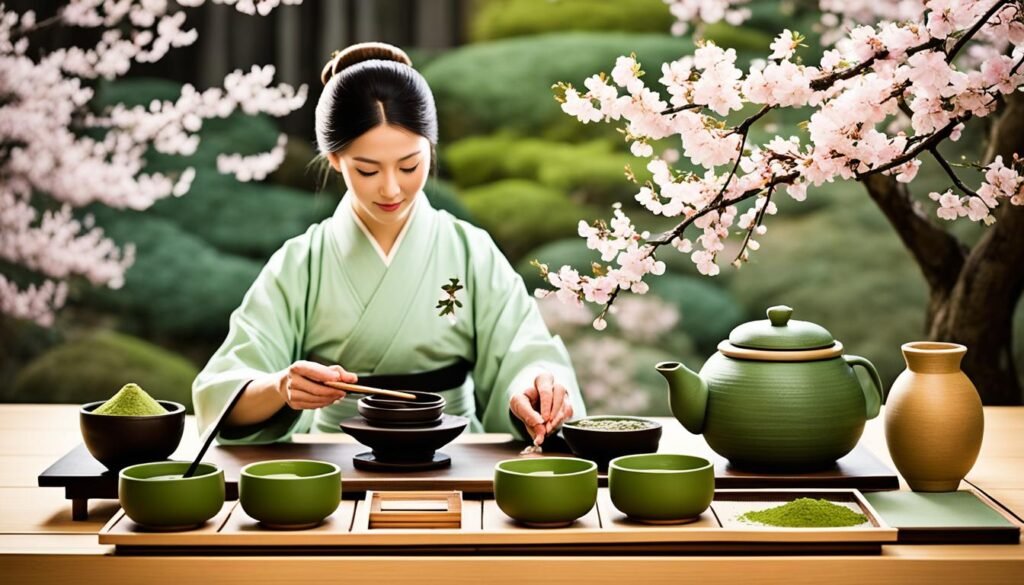
Ceylon Tea in Sri Lanka: Exploring the Flavors
Sri Lanka, also known as the “Pearl of the Indian Ocean,” is renowned for its tea production and offers a paradise for tea lovers. The country’s lush tea plantations, located amidst picturesque landscapes, produce some of the finest teas in the world.
Ceylon tea, named after the former name of Sri Lanka, is a favorite among tea enthusiasts globally. This black tea variety is known for its bold flavors, rich aroma, and vibrant colors. Grown in different regions across the country, such as Nuwara Eliya, Dimbula, and Uva, Ceylon tea exhibits unique characteristics and nuances based on the local climate and soil conditions.
Visiting tea plantations in Sri Lanka, such as the renowned Ceylon Tea Trails, provides a fascinating opportunity to explore the tea-making process and immerse yourself in the world of tea. As you walk through the scenic plantations, you’ll witness the careful cultivation, handpicking, and processing of tea leaves. Expert guides will enlighten you about the art and science behind tea production.
Experience the refreshing taste and aroma of freshly brewed Ceylon tea at every stage of its journey, from the tender saplings to the final brewed cup.

Exploring Tea Flavors
One of the highlights of visiting Sri Lanka’s tea plantations is the opportunity to savor a wide range of tea flavors. With each region offering its unique terroir, you can discover a myriad of taste profiles, from delicate and floral to strong and robust.
Here’s a taste of some popular Ceylon tea flavors:
| Tea Flavor | Description |
|---|---|
| Earl Grey | Infused with the citrusy aroma of bergamot, this classic black tea has a distinctive flavor loved by many. |
| English Breakfast | A full-bodied black tea blend with a robust flavor, perfect for starting the day or enjoying with a hearty breakfast. |
| Green Tea | Known for its fresh and grassy taste, green tea offers a lighter alternative with numerous health benefits. |
| White Tea | Delicate and subtly sweet, white tea is made from young tea leaves and buds, providing a mellow and soothing experience. |
| Oolong Tea | This partially fermented tea balances flavors from both green and black teas, resulting in a unique taste profile. |
Embark on a journey of flavor as you sip on different Ceylon tea varieties, discovering your personal favorites among these delightful options.
Sri Lanka’s tea plantations also offer tea tours where you can witness the tea manufacturing process, participate in tea tastings, and even try your hand at tea plucking. These immersive experiences allow you to gain a deeper appreciation for the craftsmanship and dedication that goes into producing exceptional teas.
Sri Lanka’s tea plantations offer a kaleidoscope of flavors, inviting tea lovers to embark on a captivating exploration of Ceylon tea.
Whether you prefer a strong and full-bodied brew or a delicate and aromatic cup, Sri Lanka’s tea plantations have something to satisfy every tea lover’s palate. Let Sri Lanka’s tea wonders transport you into a world of sensory delights, where each sip tells the story of a rich tea heritage and the passion of those who nurture it.
Tea Tours Around the World: From China to Portugal
Apart from the specific destinations mentioned earlier, there are many other tea tours around the world that offer unique experiences for tea lovers. From exploring tea plantations to immersing yourself in rich tea cultures, these tours provide a delightful journey into the world of tea.
One such destination for tea enthusiasts is Chengdu in China. Known for its locally grown tea, Chengdu offers a captivating experience where you can witness tea production firsthand. Discover the diverse flavors of Chinese tea as you visit tea gardens and learn about traditional tea-making techniques passed down through generations.
If you’re looking for a tea experience in Europe, the Azores in Portugal is a must-visit. With its lush landscapes and favorable climate, the Azores is home to one of Europe’s only tea plantations. Embark on a serene tea tour where you can witness the cultivation of tea leaves and indulge in the flavors of Portuguese tea.
“Tea is the elixir of life, and exploring different tea destinations allows us to savor its beauty and diversity.” – Unknown
Each tea destination offers its own unique traditions and cultural experiences. Whether it’s the elegance of Chinese tea ceremonies or the art of Portuguese tea blending, there is something to discover and appreciate in every corner of the world.
Tea Tours: Highlights and Experiences
| Destination | Highlights | Experiences |
|---|---|---|
| Chengdu, China | Visit tea gardens Witness tea production Learn about Chinese tea culture |
Attend a traditional tea ceremony Taste a variety of Chinese teas Explore tea markets |
| Azores, Portugal | Explore a tea plantation Enjoy breathtaking landscapes Learn about Portuguese tea production |
Participate in tea harvesting Sample local tea blends Relax in tea houses |
Embarking on a tea tour allows you to immerse yourself in the rich flavors and traditions of tea culture. Whether you choose to wander through the tea fields of China or savor the beauty of Portuguese tea gardens, these experiences are sure to leave a lasting impression on any tea enthusiast.
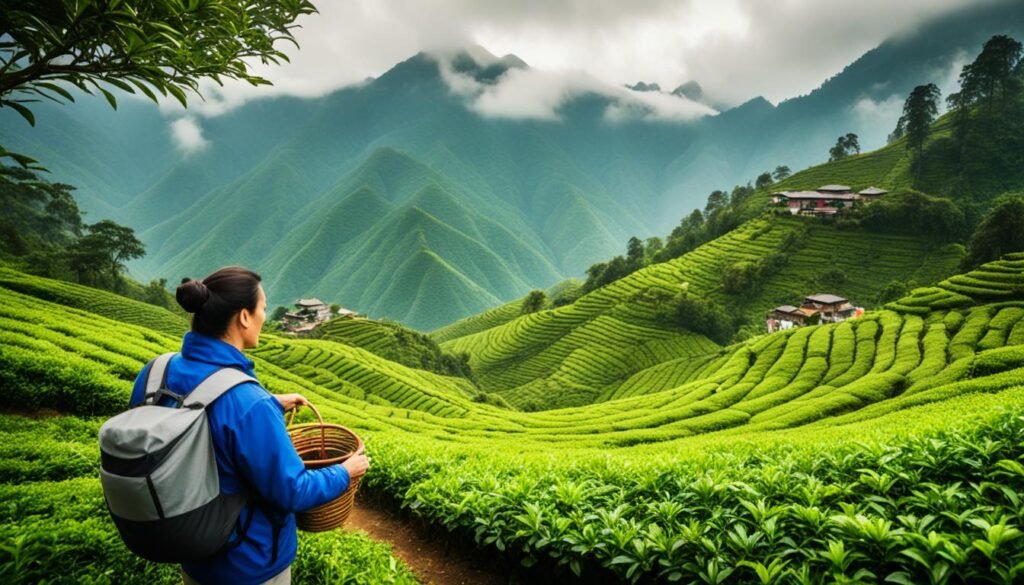
With countless opportunities to explore tea destinations around the world, tea lovers can indulge in their passion for this beloved beverage. From China to Portugal, each destination offers its own charm and delights, making tea tours an essential part of any tea lover’s journey.
Conclusion
Food destinations for coffee and tea lovers offer a delightful and flavorful journey that immerses visitors in the rich cultures and traditions associated with these beloved beverages. Whether you are a coffee connoisseur or a tea enthusiast, exploring these destinations allows you to discover the unique flavors and experiences that coffee and tea cultures have to offer.
From the lush coffee plantations of Costa Rica to the serene tea ceremonies in Japan, each food destination has its own distinct coffee and tea traditions. By visiting these destinations, you can deepen your understanding of the local culture and indulge in the exquisite flavors that define each region.
Coffee culture thrives in countries like Costa Rica and Vietnam, where you can savor the bold and flavorful coffees made from Arabica and Robusta beans. On the other hand, tea culture flourishes in places like Morocco and Sri Lanka, where you can experience the warm hospitality and traditional tea ceremonies that celebrate the art of tea preparation.
For coffee and tea lovers, these food destinations offer a unique opportunity to explore the world through the lens of these beloved beverages. So whether you’re craving a rich cup of coffee or a soothing cup of tea, embark on a journey to these food destinations and unlock a world of flavors, aromas, and cultural experiences.

